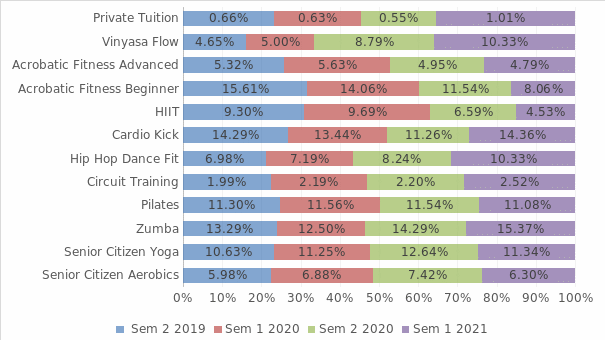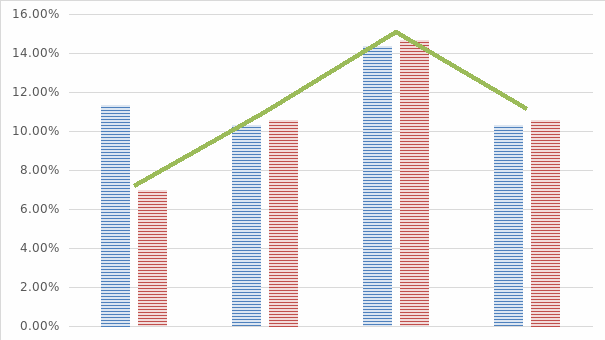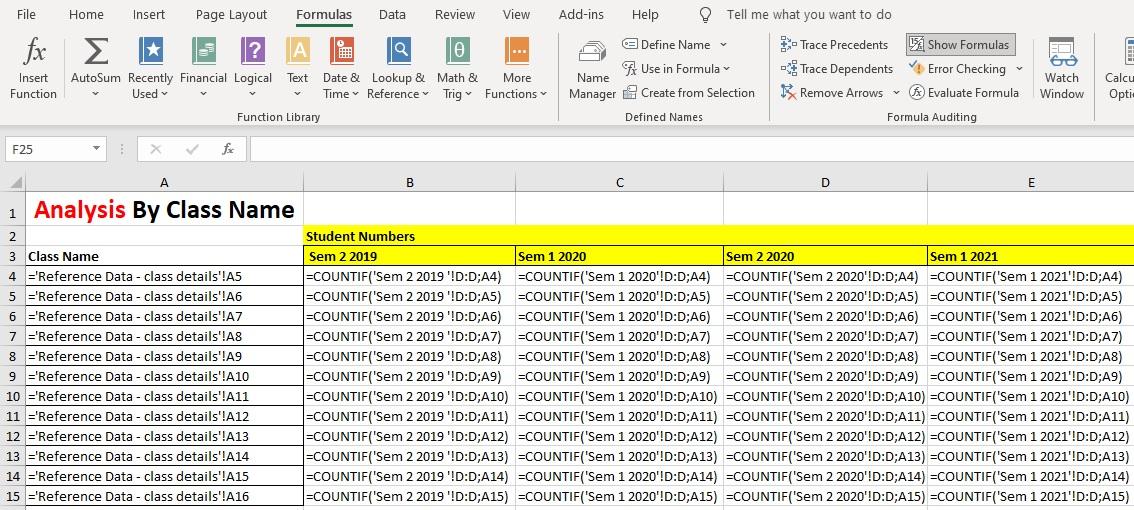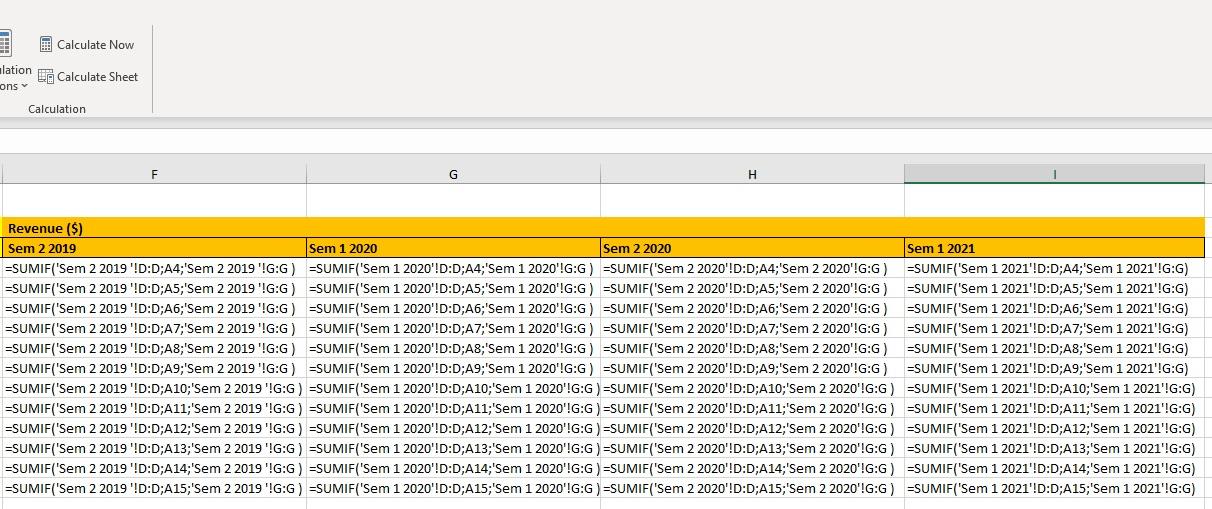Introduction
“Keep movin’ Gym” is a fitness studio that offers a number of different classes and training for people in Adelaide, South Australia. The studio owner is willing to change the current timetable and increase profitability level in the future. The management wants to evaluate the effectiveness of the business and discount system introduced in the last two semesters that allows discounts for clients who enroll in more than one class.
The report is based on data collected from the last four class semesters to evaluate the current situation and give predictive analysis and recommendations for the business. The data also featured reference details, like staff payments information and monthly expenses for electricity and cleaning. The report will focus on the analysis of profit and discuss possible methods for maximizing the profit through changes in the timetable, reducing additional costs, and following established trends among clients.
Profit Growth Analysis
Descriptive Analysis
According to the conducted analysis, the majority of the studio’s income in the first periods was mainly sourced in Acrobatic Fitness for beginners. Through several semesters the number of enrollments to the class significantly declined. In the second semester of 2019, the class counted 47 students, contributing to 16% of total revenue, as shown in Figure 1. In the first semester of 2021, the number of students declined to 32, contributing to 8% of total revenue. On the other hand, data on Zumba classes shows an increased number of students, from 40 in 2019 to 61 in the second semester of 2021. Zumba classes now present a major part (15%) of revenue compared to other classes, as shown in Figure 1. Classes for Cardio Kick maintain second place in the revenue chart throughout several semesters, which indicates that the class provides a steady income source for the studio.
Although the number of students in Cardio Kick class increased in the second semester of 2021 compared to 2019, the revenue percentage does not reflect that change, as shown in Figure 2. Due to the introduction of discounts to clients who take more than one class, the studio is missing additional income. In 2021, 78 clients used discounts for enrolling in more than two classes. Most of the discounts were concentrated in Vinyasa Flow classes, with a total of 15 discounts given to clients. In four classes, which include Vinyasa flow, Hip Hop Dance Fit, Cardio Kick, and Senior citizen yoga, the lost revenue composed more than a half of percent from total revenue.


Predictive Analysis
The recommendations for the business for maximization of the profits mainly feature concentrating on retrieving the lost revenue. Increasing future profitability in the “Keep movin’ Gym” could be done by eliminating the current discount system and introducing an improved version of the discount policy or additional marketing support for particular classes. As the current discount system offers drastic ranges from 36 to 60 dollars, in combination, they present a significant threat for the final revenue.
As the discounts system’s primary purpose was to lure existing clientele into trying new classes and maximize profit, the studio requires developing a more cost-effective alternative. For example, with enrollment in one class, free complimentary trial lessons in classes of choice could be more effective in making the clients familiar with other classes. That way, the business would benefit from revenue increase without additional expenses, and clients would benefit from the opportunity to find classes that suit them the most.
Another method to increase the profit is to follow the trends in the market and clients and provide additional marketing support for more popular classes. As the analysis results show that there is a tendency among clients to enroll in Zumba classes, the management could follow the trend and push the Zumba classes to the existing clientele. Alternatively, the studio could advertise their Zumba classes to attract new clients. Both options require addition of more Zumba classes to the timetable and reducing time for less popular classes, like Acrobatic Fitness for beginners.
Discussion of business issues
One of the business issues detected in the studio’s activities is that the management does not specify the sundries expenses category. The sundries expenses category is the most inconsistent cost item in the reference data and should be accompanied by a thorough explanatory note on each operation in the category. Inconsistencies in the category could be explained by the absence of a plan for sundries expenses. One of the foundations of profit maximization is minimizing additional expenses. Thus, the studio’s management should develop a budgeting plan for all required additional expenses and follow that plan to maximize their profits.
Conclusion
Summary of major findings
The analysis’ findings show that at this stage of business development, introducing the extensive system of discounts presents a significant threat to profit. Although senior discounts should remain, the system that allows discounts for clients and families who enroll in more than one class results in lost revenue rather than increasing popularity of certain classes. Zumba classes became more popular in the last semester, and Cardio Kick classes remain a steady source of income for the studio. From inconsistency in the sundries item in the list of expenses, one could suggest that the studio does not incorporate a budgeting plan in its activities, which results in increased additional expenses and lost profit.
Recommendations
Based on predictive analysis, the studio should revise the current discount system and develop a more cost-effective alternative as the number of discounts among existing clientele would negatively influence profit eventually. Additionally, the studio should revise the current timetable and schedule more Zumba and Cardio Kick classes as they offer more opportunities to increase profit. Following the current trend among clients, the studio could relocate the saving from the revised discount system into the marketing budget for popular classes like Zumba and Vinyasa Flow to attract new clients. Finally, the business needs to implement or revise the expenses budgeting plan and stabilize the sundries category.
Personal Reflections
Reflecting on my data analysis skills before studying the course, I could say that I could perform calculations with provided data. However, I did not have enough knowledge to apply the results to the specific case and logically connect the cause and its effect. Additionally, I was not sure what effects each cause could make and viewed them as complex. On the other hand, after studying the course, I improved my analytical skills, and in this specific task, I was able to put these skills into practice and establish logical connections in the data and material.
The part of the data analysis that I find was easy to write is the descriptive analysis part, as it primarily focuses on comparing different indicators. The part that was more difficult for me was the predictive analysis, but with the help of additional data for reference, I managed to write suitable recommendations for the business based on the predictive analysis. According to Abbasi et al. (2018), analytical skills present the most desirable skills among graduates in business, as they prepare students for business challenges.
The primary transferable skill gained from this course is critical thinking, which lays the foundation for understanding challenges in business, studies, and life. In the article on improving analytical skills, Sarah et al. (2021) suggested that learning the Predict-Observe-Explain model could improve critical thinking, so I assume that I would improve my analytical skills in professional development by gaining experience. Conveying the analysis results to other people requires writing skills, so I assume that learning the basics of analytical writing would help me improve my analytical skills (Gomez-Laich et al., 2019).
References
Abbasi, F. K., Ali, A., & Bibi, N. (2018). Analysis of skill gap for business graduates: managerial perspective from banking industry. Education + Training, 60(4), 354–367. Web.
Gomez-Laich, M. P., Miller, R. T., & Pessoa, S. (2019). Scaffolding analytical argumentative writing in a design class: A corpus analysis of student writing. Linguistics and Education, 51, 20–30. Web.
Sarah, S., Khanif, A., & Saputra, A.T. (2021). The effectiveness of POE (Predict-Observe-Explain) learning model for improving student analytical skills. Jurnal Ilmu Pendidikan Fisika, 6(1), 23-29.
Appendix A: Screen shots of calculations


